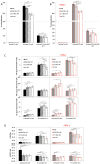A Systematic Study of the Effect of Different Molecular Weights of Hyaluronic Acid on Mesenchymal Stromal Cell-Mediated Immunomodulation
- PMID: 26820314
- PMCID: PMC4731468
- DOI: 10.1371/journal.pone.0147868
A Systematic Study of the Effect of Different Molecular Weights of Hyaluronic Acid on Mesenchymal Stromal Cell-Mediated Immunomodulation
Abstract
Introduction: Osteoarthritis (OA) is associated with chronic inflammation, and mesenchymal stromal cells (MSCs) have been shown to provide pain relief and reparative effects in clinical investigations. MSCs are often delivered with hyaluronic acid (HA), although the combined mechanism of action is not fully understood; we thus investigated the immunomodulatory effects of combining MSCs with different molecular weights (MW) of HA.
Methods: HAs with MWs of 1.6 MDa (hHA), 150 kDa or 7.5 kDa, were added to MSCs alone or MSC-immune cell co-cultures. Gene expression analyses, flow cytometry and cytokine measurements were assessed to determine the effect of HAs on the MSC interactions with immune cells.
Results: MSCs in the presence of HAs, in both normal and lymphocyte-conditioned medium, showed negligible changes in gene expression. While addition of hHA resulted in increased proliferation of activated lymphocytes, both in the presence and absence of MSCs, the overall combined effect was a more regulated, homeostatic one; this was supported by higher ratios of secreted IL10/IFNγ and IL10/IL2, in lymphocyte cultures, than with lower MW HAs or no HA, both in the presence and absence of MSCs. In addition, examination of monocyte-derived macrophages showed an increased M2 macrophage frequency (CD14+CD163+CD206+) in the presence of hHA, both with and without MSCs.
Conclusions: hHA produces a less pro-inflammatory environment than lower MW HAs. Moreover, combining hHA with MSCs has an additive effect on the MSC-mediated immunomodulation, suggestive of a more potent combination treatment modality for OA.
Conflict of interest statement
Figures





Similar articles
-
The effect of mesenchymal stromal cell-hyaluronic acid hydrogel constructs on immunophenotype of macrophages.Tissue Eng Part A. 2011 Oct;17(19-20):2463-71. doi: 10.1089/ten.TEA.2010.0716. Epub 2011 Jun 24. Tissue Eng Part A. 2011. PMID: 21554192 Free PMC article.
-
Trained murine mesenchymal stem cells have anti-inflammatory effect on macrophages, but defective regulation on T-cell proliferation.FASEB J. 2019 Mar;33(3):4203-4211. doi: 10.1096/fj.201801845R. Epub 2018 Dec 6. FASEB J. 2019. PMID: 30521384 Free PMC article.
-
The immunomodulatory function of equine MSCs is enhanced by priming through an inflammatory microenvironment or TLR3 ligand.Vet Immunol Immunopathol. 2018 Jan;195:33-39. doi: 10.1016/j.vetimm.2017.10.003. Epub 2017 Oct 31. Vet Immunol Immunopathol. 2018. PMID: 29249315
-
Immunomodulation by Mesenchymal Stem Cells (MSCs): Mechanisms of Action of Living, Apoptotic, and Dead MSCs.Front Immunol. 2019 Jun 4;10:1191. doi: 10.3389/fimmu.2019.01191. eCollection 2019. Front Immunol. 2019. PMID: 31214172 Free PMC article. Review.
-
Mesenchymal stromal cells and immunomodulation: A gathering of regulatory immune cells.Cytotherapy. 2016 Feb;18(2):160-71. doi: 10.1016/j.jcyt.2015.10.011. Cytotherapy. 2016. PMID: 26794710 Review.
Cited by
-
Antinociceptive effects of hyaluronic acid on monoiodoacetate-induced ankle osteoarthritis in rats.J Pain Res. 2019 Jan 3;12:191-200. doi: 10.2147/JPR.S186413. eCollection 2019. J Pain Res. 2019. PMID: 30655688 Free PMC article.
-
Immunomodulatory potential of secretome from cartilage cells and mesenchymal stromal cells in an arthritic context: From predictive fiction toward reality.Front Med (Lausanne). 2022 Oct 12;9:992386. doi: 10.3389/fmed.2022.992386. eCollection 2022. Front Med (Lausanne). 2022. PMID: 36314003 Free PMC article.
-
Using biomaterials to improve mesenchymal stem cell therapies for chronic, nonhealing wounds.Bioeng Transl Med. 2023 Sep 13;9(1):e10598. doi: 10.1002/btm2.10598. eCollection 2024 Jan. Bioeng Transl Med. 2023. PMID: 38193114 Free PMC article. Review.
-
Patients with Obstructive Sleep Apnea Have Altered Levels of Four Cytokines Associated with Cardiovascular and Kidney Disease, but Near Normal Levels with Airways Therapy.Nat Sci Sleep. 2021 Mar 25;13:457-466. doi: 10.2147/NSS.S282869. eCollection 2021. Nat Sci Sleep. 2021. PMID: 33790678 Free PMC article.
-
Challenges and advances in clinical applications of mesenchymal stromal cells.J Hematol Oncol. 2021 Feb 12;14(1):24. doi: 10.1186/s13045-021-01037-x. J Hematol Oncol. 2021. PMID: 33579329 Free PMC article. Review.
References
-
- Blom AB, van Lent PL, Libregts S, Holthuysen AE, van der Kraan PM, van Rooijen N, et al. Crucial role of macrophages in matrix metalloproteinase–mediated cartilage destruction during experimental osteoarthritis: Involvement of matrix metalloproteinase 3. Arthritis Rheum. 2007;56: 147–157. 10.1002/art.22337 - DOI - PubMed
-
- Ashford S, Williard J. Osteoarthritis: A review. Nurse Pract. 2014;39: 1–8. - PubMed
Publication types
MeSH terms
Substances
LinkOut - more resources
Full Text Sources
Other Literature Sources
Research Materials

